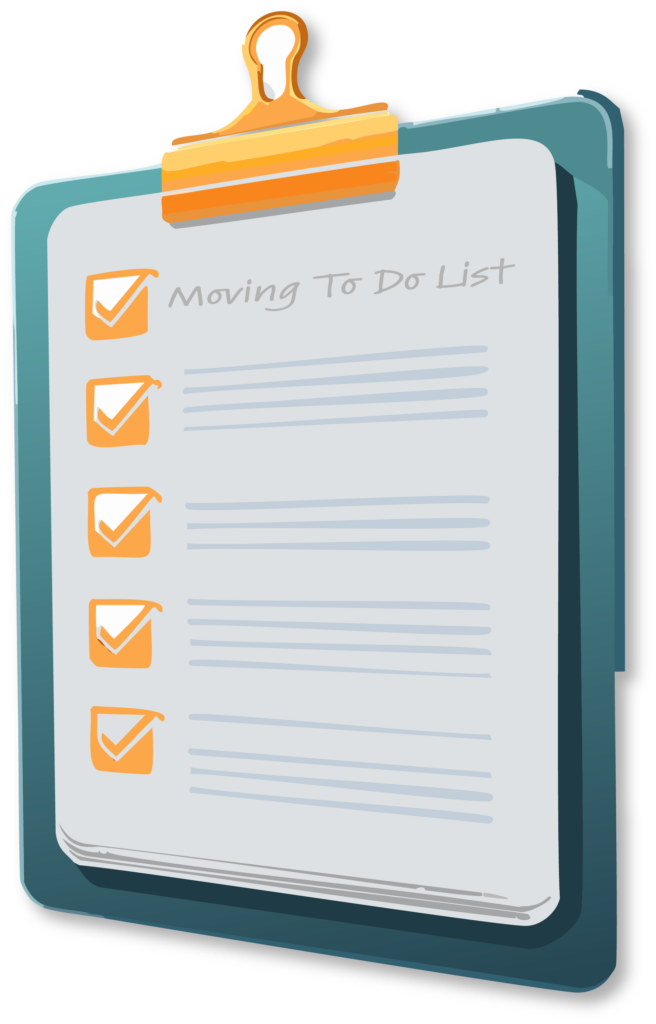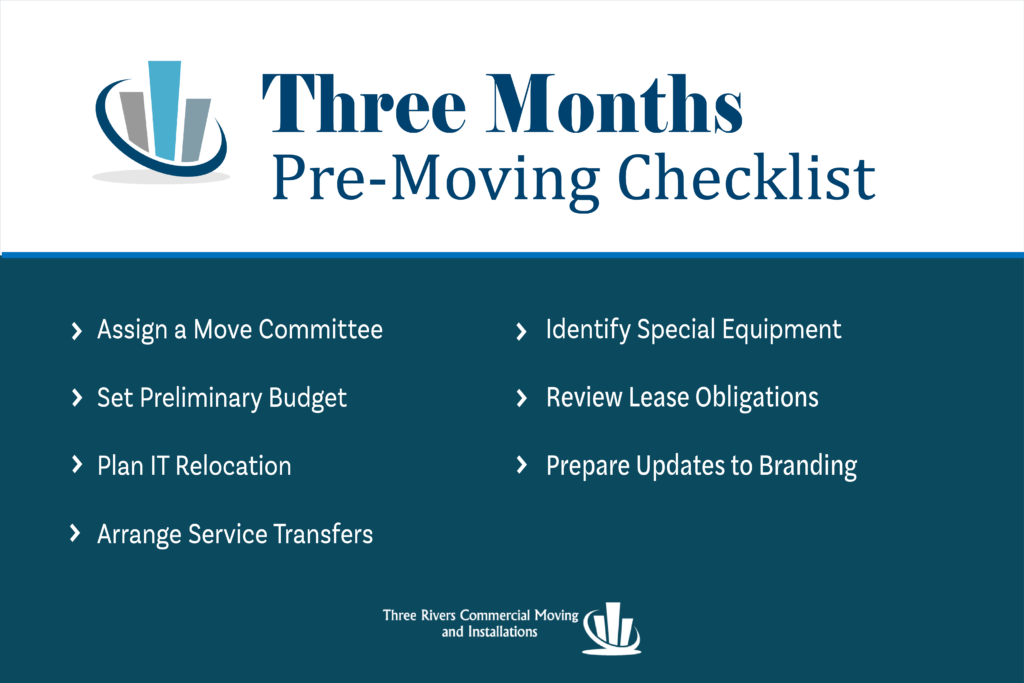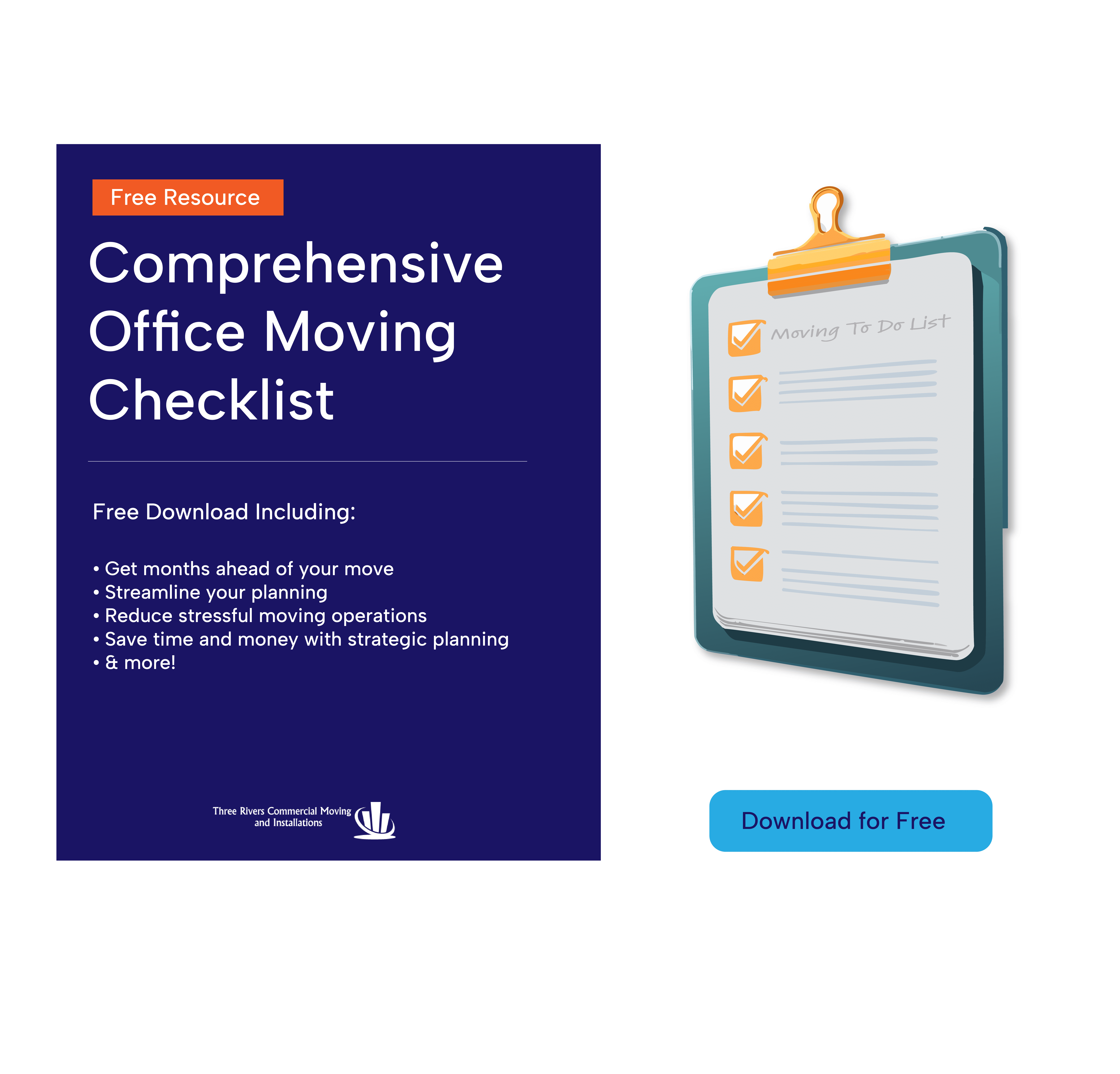Planning any move requires meticulous organization and coordination to ensure a smooth transition. In this comprehensive office moving checklist, we'll guide you through each phase of the move, from three months prior to the move date to post-move support. Review each part as you need, or print it out for future reference. As professional movers ourselves, we share this checklist with clients to guide them on the best practices of relocating, and to ensure nothing falls through the cracks.

Grab your free downloadable checklist now! It’s neatly formatted to help you effortlessly organize your move. Implement the strategies we've outlined to streamline your planning process.
Getting tedious tasks completed at the three-month mark will be essential and can save you time in the long-run. In this section, we'll outline the crucial steps to take during this initial phase of planning.
Designate dedicated planning team of individuals responsible for overseeing and coordinating the move process. This committee will serve as the central point of contact for all move-related activities. If you have a large organization, it may be best to have a moving representative from each department on this committee.
Determine the financial resources available for the move, including expenses related to logistics, equipment, services, and any unforeseen costs. This preliminary budget will provide guidance for decision-making throughout the planning process.
Evaluate whether the complexity and scale of the move warrant the expertise of a moving management company or space planning consultant. Their insights and guidance can streamline the process and minimize potential challenges. A partner like Three Rivers Commercial Moving and Installations consult on many large-scale moves like healthcare or warehousing relocations.
Collaborate closely with your IT provider or support person to plan the relocation of your office equipment like servers and ensure minimal disruption to critical systems and operations. This can also include determining set-ups and cord management.
Reach out to your telephone provider to arrange for new numbers or the relocation of existing services. Consider alternative options if necessary to optimize communication channels during and after the move.
Determine if any specialized equipment, such as copiers, lab equipment, or manufacturing machinery, requires approved vendors for safe transportation. Addressing these needs early will prevent delays and ensure equipment integrity. This is more likely with Healthcare moves and the relocation of X-Ray machines or medical imaging.
Discuss with your landlord your intent to move. Thoroughly examine your existing lease agreement to understand restoration requirements and conditions for returning the current space to the landlord. Be sure to bring any questions regarding after move cleaning services and restoring the old space after you've gone. Determine if a security deposit will be refunded.
Be sure to get all the information you need to determine when you have to coordinate with your telecommunications/data provider to schedule a cut-over date for transitioning services to the new location. This ensures a smooth transfer of communication infrastructure with minimal downtime. Some companies will only schedule out 30 days. Be sure to know your requirements.
Secure the necessary logistical support by reserving building elevators for move-out and move-in periods. Additionally, order keys from the building management to facilitate access during the relocation process. This can take some time if you need to program new access cards to the building for employees so preparing this far in advance is helpful.
Determine the location of signage at the new premises and hire a signage vendor to plan, obtain approval for, and install new signage as needed. Effective signage ensures visibility and facilitates smooth navigation for employees, clients, and visitors.
Collaborate with your moving company to outline specific moving goals and expectations. Clear communication and alignment on objectives will guide the planning and execution phases of the move. Most commercial movers are very accommodating.
Update your branding materials by ordering new stationery, business cards, and forms with the updated address and contact information. Maintaining consistency across communication channels enhances professionalism and brand identity. All of these may need the help of graphic designers and printing companies, so be sure to plan ahead.
Inform clients, vendors, and service providers, such as coffee services and vending machine suppliers, of the upcoming address change. Clear communication minimizes disruptions to business operations and fosters continued collaboration.
Notify government agencies, including the IRS, Franchise Tax Board, Secretary of State, and Employment Development Department, of the change in business address. Compliance with regulatory requirements ensures seamless business continuity.
You can put in your USPS change of address either online or in-person and up to 90 days prior to moving. This is also important for maintaining your business's search engine optimization consistency, known as NAP (Name, Address, Phone Number).
Inform your insurance carrier about the address change to ensure adequate coverage at the new premises. Compliance with lease requirements and landlord obligations mitigates potential risks and liabilities during the relocation process.

Two months and counting. As your business move approaches, it's time to ramp up preparations to ensure a stress-free office relocation. Focusing on coordination, communication, and logistics becomes paramount.
Collaborate closely with your IT team to develop a comprehensive plan for moving servers, desktops, and PBX systems. Establish clear timelines and protocols to minimize downtime and ensure seamless transition of IT infrastructure.
Formulate a move team comprising representatives from each department, tasked with overseeing specific aspects of the relocation. Schedule weekly coordination meetings to keep everyone aligned and address any emerging issues promptly.
Provide employees with clear layout plans for their new workspaces. Work closely with the moving team to gather and distribute these plans. Clear communication ensures a smooth transition.
Draft a preliminary move schedule outlining key milestones, activities, and deadlines leading up to moving day. Consider factors such as equipment installation, office setup, and employee orientation to create a realistic timeline for the entire relocation process.
Create a systematic labeling/tagging scheme and assign move numbers to streamline the packing and unpacking process. Consistent labeling ensures items are easily identified and placed in their designated locations at the new premises.
Engage in discussions with your company to assess and determine appropriate move insurance coverage. Protecting valuable assets during transit is essential, and aligning on insurance needs ensures comprehensive protection against unforeseen risks.
Generate buzz and excitement about the upcoming move by crafting press releases to highlight the benefits and enhancements of the new location. Engage with media outlets to amplify your message and showcase the positive aspects of the transition.
Refine and finalize the move schedule based on updated timelines and logistical considerations. Address any potential conflicts or challenges to ensure a seamless execution of the relocation plan.
Review and confirm the finalized move schedule with all stakeholders, including vendors and service providers. Ensure alignment on key milestones and logistics to prevent last-minute disruptions.
Conduct a comprehensive orientation meeting for employees to provide essential information and guidelines for the upcoming move. Address questions, concerns, and logistical details to prepare employees for the transition.
Arrange for the delivery of packing materials and labels to facilitate the packing process. Ensure sufficient supplies are available to accommodate the needs of all departments and personnel involved in the move.
Assemble welcome packets containing essential information about the new space, including restroom locations, gym facilities, break rooms, and copy areas. Provide employees with a comprehensive guide to navigate and familiarize themselves with the new environment. This will be distributed when employees arrive at the new locations.
As the moving day draws nearer, completing these tasks one month and two weeks before the move ensures thorough preparation and smooth execution. From fine-tuning logistics to engaging employees, good planning sets the stage for a successful transition to the new location.
Ensure an ample supply of packing materials and labels is available by scheduling additional deliveries as needed. Having sufficient supplies on hand streamlines the packing process and minimizes delays.
Label the destination site using room numbers and equipment IDs to guide movers and facilitate efficient placement of items. Clear labeling ensures items are delivered to their designated locations, minimizing confusion during unpacking.
Provide contact lists containing emergency, on-site, and on-call contact information to all relevant parties. This ensures accessibility to essential contacts and facilitates prompt communication in case of emergencies or unforeseen issues.
Prepare the building for the move by implementing protective measures such as surface protection and corner guards. These precautions help prevent damage to walls, floors, and other surfaces during the relocation process.
Distribute new security ID cards or key entry badges to authorized personnel for access to the new location. Ensuring secure access enhances safety and security during the move and after relocation.
Conduct training sessions for all employees on emergency procedures specific to the new location. This includes protocols for fire safety, evacuation procedures, and other relevant emergency response measures.
As close as possible to moving day, change locks and access codes at the new location to enhance security and restrict unauthorized access. This precaution safeguards sensitive areas and assets during the transition.

Designate move liaisons at both the origin and destination sites to oversee and coordinate move-related activities. These liaisons serve as points of contact for communication and coordination between movers and employees.
Arrange for on-site assistance to address move-related questions, especially in regards to office layouts and new floor plan requirements. Your commercial mover typically covers this; however, if you opt for a DIY approach, ensure it is well-managed. The more efficient the movers can be with an office space blueprint, the easier it will be for everyone.
Conduct a comprehensive job walk each day of the move to ensure progress is on schedule and identify any goods or walls that may have been damaged during transit. Prompt identification allows for timely resolution of issues.
Distribute keys and/or access cards to authorized personnel for the new location. Proper allocation of access credentials ensures seamless access and security for employees.
Welcome employees to their new workspaces by distributing welcome packets containing essential information about the new facilities, amenities, and resources available to them.
To ensure your business maintains its online visibility and accessibility, don't forget to update your Google listing with the new office address. This will help clients and customers find your new location easily and ensure accurate information is displayed on search results. Updating your listing can be done through the Google My Business platform.
Continue operating 'Move Command Central' to support employee inquiries, manage lost items, track action items, and address any remaining concerns post-move.
Dispatch appropriate teams to handle post-move set-up tasks, such as hanging whiteboards, installing equipment, and configuring workstations. This ensures a smooth transition to normal business operations at the new location.
Provide employees with updated contact lists and layouts of department locations in the new premises. Clear communication and accessibility to information facilitate adjustment and navigation within the new environment.
Collect all access items, including security cards, keys, and parking passes, from employees and vendors. Arrange for the return of deposits held by the landlord for these items, ensuring compliance with lease agreements.
Compile a move punch list identifying any outstanding action items or deficiencies requiring attention. Coordinate with relevant contractors and stakeholders to address these items systematically and ensure a successful post-move transition.
Completing the tasks outlined during move week, on move day(s), and in the post-move phase ensures a smooth transition and sets the stage for operational success at the new location. By maintaining clear communication, addressing logistical challenges, and providing support to employees, you can navigate the complexities of a business move with confidence and efficiency. Go ahead and print this office moving checklist and mark off the things you complete as you go.
